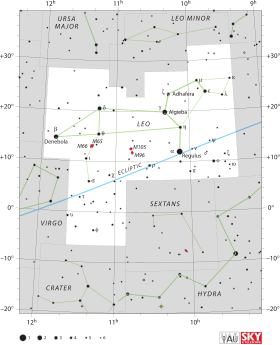Pi Leonis (en abrégé π Leo étoile géante de cinquième magnitude de la constellation zodiacale du Lion . Située non loin de l'écliptique , il lui arrive d'être occultée par la Lune [ 12] parallaxe annuelle par le satellite Gaia a.l. pc [ 1] vitesse radiale de +22 km/s [ 6]
Pi Leonis est une étoile géante rouge évoluée de type spectral M2 III [ 4] branche asymptotique des géantes (AGB) du diagramme de Hertzsprung-Russell [ 3] massive que le Soleil et son rayon est environ 85 fois plus grand que le rayon solaire [ 9] lumineuse que le Soleil [ 11] température de surface est de 3 757 K [ 10] étoile variable irrégulière à longue période de type LB, dont la magnitude apparente varie entre 4,66 et 4,76 sans que l'on puisse définir une période[ 2]
↑ a b c d e et f
(en) A. Vallenari et al. Gaia collaboration), « Gaia Data Release 3 : Summary of the content and survey propertiesAstronomy & Astrophysics vol. 674, juin 2023 , article no A1 (DOI 10.1051/0004-6361/202243940 Bibcode 2023A&A...674A...1G arXiv 2208.00211 Notice Gaia DR3 pour cette source sur VizieR .
↑ a b et c (en) « VSX : Detail for NSV 4699 The International Variable Star Index , AAVSO (consulté le 11 décembre 2024 ) ↑ a et b (en) Olin J. Eggen , « Asymptotic giant branch stars near the sun », The Astronomical Journal vol. 104, no 1, juillet 1992 , p. 275–313 (DOI 10.1086/116239 Bibcode 1992AJ....104..275E ↑ a et b (en) W. W. Morgan et P. C. Keenan , « Spectral Classification », Annual Review of Astronomy and Astrophysics vol. 11, 1973 , p. 29 (DOI 10.1146/annurev.aa.11.090173.000333 Bibcode 1973ARA&A..11...29M ↑ a et b (en) J.-C. Mermilliod , « Compilation of Eggen's UBV data, transformed to UBV (unpublished) », Catalogue of Eggen's UBV data SIMBAD , 1986 (Bibcode 1986EgUBV........0M ↑ a et b (en) B. Famaey et al. Spectroscopic binaries among Hipparcos M giants. I. Data, orbits, and intrinsic variations », Astronomy & Astrophysics vol. 498, no 2, 2009 , p. 627–640 (DOI 10.1051/0004-6361/200810698 Bibcode 2009A&A...498..627F arXiv 0901.0934 ↑ a et b (en) * pi. Leo -- Variable Star sur la base de données Simbad Centre de données astronomiques de Strasbourg .↑ (en) E. Anderson et Ch. Francis , « XHIP: An extended Hipparcos compilation », Astronomy Letters vol. 38, no 5, mai 2012 , p. 331 (DOI 10.1134/S1063773712050015 Bibcode 2012AstL...38..331A arXiv 1108.4971 ↑ a b et c (en) Pierre Kervella , Frédéric Arenou et Frédéric Thévenin , « Stellar and substellar companions from Gaia EDR3. Proper-motion anomaly and resolved common proper-motion pairs », Astronomy & Astrophysics vol. 657, 2022 , p. 657 (DOI 10.1051/0004-6361/202142146 Bibcode 2022A&A...657A...7K arXiv 2109.10912 ↑ a b c et d (en) Nicolás Cardiel et al. Synthetic RGB photometry of bright stars: Definition of the standard photometric system and UCM library of spectrophotometric spectra », Monthly Notices of the Royal Astronomical Society vol. 504, no 3, 2021 , p. 3730 (DOI 10.1093/mnras/stab997 Bibcode 2021MNRAS.504.3730C arXiv 2103.17009 ↑ a et b
(en) A. G. A. Brown et al. Gaia collaboration), « Gaia Data Release 2 : Summary of the contents and survey propertiesAstronomy & Astrophysics vol. 616, août 2018 , article no A1 (DOI 10.1051/0004-6361/201833051 Bibcode 2018A&A...616A...1G arXiv 1804.09365 Notice Gaia DR2 pour cette source sur VizieR .
↑ (en) Nathaniel M. White et Barry H. Feierman , « A Catalog of Stellar Angular Diameters Measured by Lunar Occultation », The Astronomical Journal vol. 94, septembre 1987 , p. 751 (DOI 10.1086/114513 Bibcode 1987AJ.....94..751W
Liens externes
